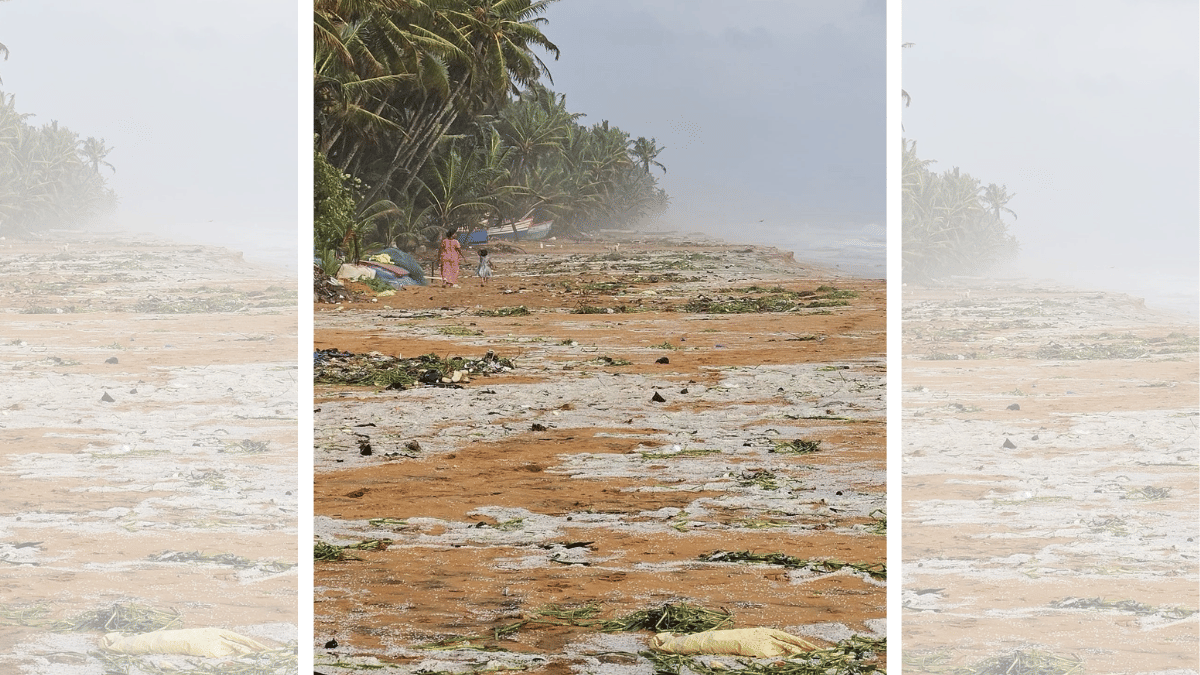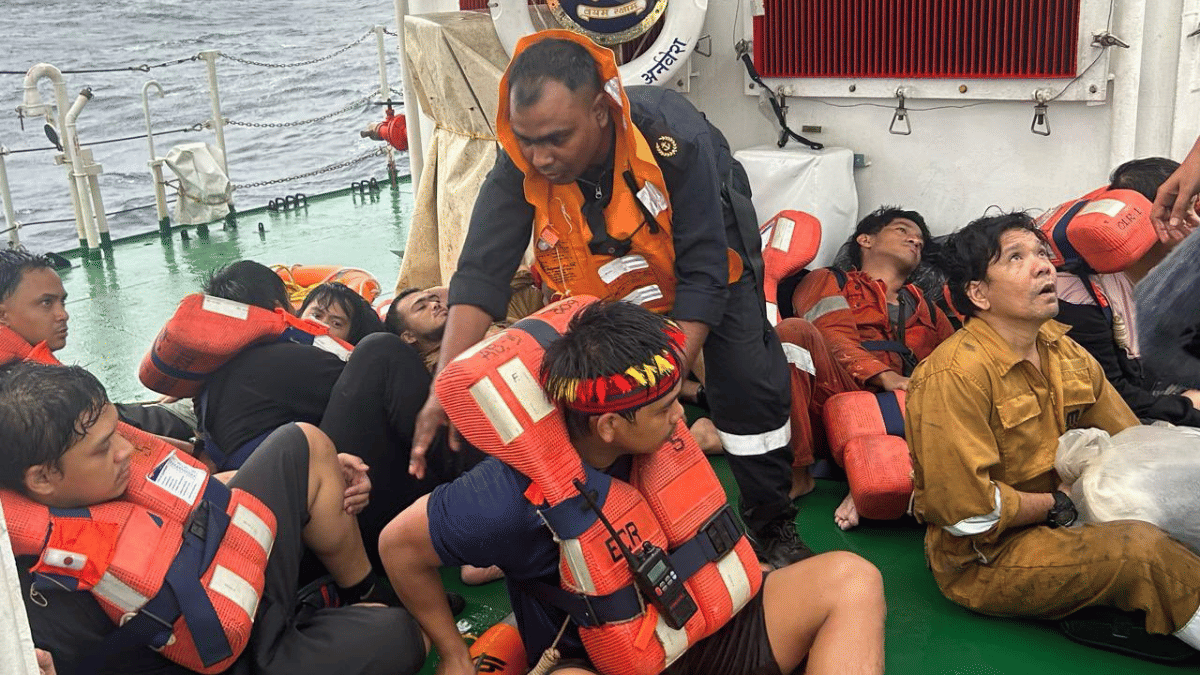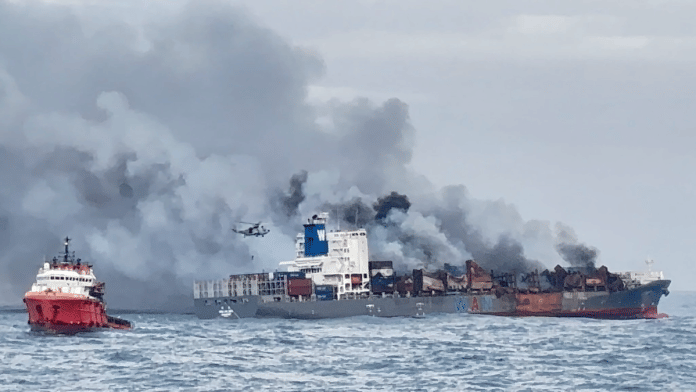Thiruvananthapuram: Two weeks ago, 70-year-old M. Ambros in the coastal Kerala village of Pallithottam watched the waves bring in something he’d never seen before: wooden logs, paint bottles, plastics, and even cashew nuts.
The debris was traced back to the sinking of a container ship, MSC ELSA 3, off the Kochi coast on 24 May. Even as the fisheries department and local volunteers struggled to clean up the shoreline, another maritime mishap involving a Singapore-flagged ship, WAN HAI 503, occurred off the coast of Kozhikode on 9 June.
The latest incident occurred farther from the shore and hasn’t yet caused significant disruption.
But as life slowly returns to normal for Ambros and others after a week-long pause in fishing, a deeper, more unsettling fear remains beneath the fragile calm: that the two maritime disasters in quick succession may threaten their livelihoods again.
“The sea still brings in wooden logs every now and then. But the real worry is the paint and chemicals are still out there in the water. They’ll settle on the seabed, and over time, they’ll kill the fish,” Ambros says.
He also expressed concern that debris from the second incident, though it occurred near Kozhikode district, could wash ashore along the southern coast, including Kollam, given the southward sea current. To add to his worry, a container and a lifeboat from WAN HAI 503 washed ashore on the Alappuzha coast on Monday morning.
While Pallithottam and other coastal villages are grappling with waves of debris, in the state capital Thiruvananthapuram, government bodies are racing to mount a coordinated response to the growing environmental threat.
In just over two weeks, Kerala has found itself confronting the fallout of two maritime mishaps, both triggering environmental concerns and testing its emergency response systems.
From debris washing ashore in coastal villages to round-the-clock coordination among disaster management and pollution control agencies, the twin disasters have not only disrupted local livelihoods but also raised pressing questions about maritime safety, the long-term ecological impact on Kerala’s fragile coastline and the possible contamination of fish. They have also sparked political controversy over the alleged delay in taking action against the companies that own the ships.
The Kerala State Disaster Management Authority (KSDMA), the State Pollution Control Board, the Indian Coast Guard, and the Directorate General of Shipping have been holding frequent meetings to assess the situation involving both maritime incidents, each significant in scale and a serious test of the state’s disaster management capacity.
“So far, we’ve been managing the existing machinery, with support from the Directorate General of Shipping and the Coast Guard,” said Ramya G., Senior Environmental Engineer at the pollution control board.
She added the shipping companies involved had been instructed to carry out shoreline clean-up operations and begin salvage efforts for the vessels.
Ramya also noted that the government is continuously sampling water and soil in the affected areas under the supervision of the Board’s regional offices and the district collectors.
The government has set up Rapid Response Teams in all coastal districts and formed district-level monitoring groups to oversee container handling and sampling efforts.

Local bodies have mobilised hundreds of volunteers, including Kudumbasree and Haritha Karma Sena members, in the affected southern districts to help in shoreline clean-up activities, which primarily involve collecting nurdles (plastic pellets) and other debris.
“In both cases, there has been no shoreline oil spill at an alarming level,” Ramya confirmed. She added that while traces of oil were detected in waters near Alappuzha, they were currently not a cause for concern.
Two incidents & a political controversy
The Liberian-flagged MSC ELSA 3 sank 25 May, approximately 4.6 nautical miles off the Thottappally spillway in Alappuzha. In the days that followed, debris, including plastic pellets, cashews, wood and other cargo, began washing up along the southern Kerala coast and even reached parts of neighbouring Tamil Nadu.
According to the KSDMA, the sunken vessel was carrying 367 tonnes of heavy fuel oil and 64 tonnes of diesel, posing a significant risk of an oil spill. It was also loaded with 13 containers of hazardous calcium carbide and 65–70 containers of plastic pellets.
The KSDMA has so far found 61 containers along a 120-km coastal stretch between Alappuzha and Thiruvananthapuram, with four containers still missing. Hundreds of volunteers are collecting nurdles washing ashore daily and had collected 65 tonnes as of Monday morning.
According to the KSDMA and the Director General of Shipping, minor oil seepage is reported from the ship.

But that was not all. Barely two weeks later, the state’s coastal north witnessed another mishap when container vessel WAN HAI 503, en route from Colombo to Mumbai, caught fire approximately 144 km northwest of Kozhikode.
According to the KSDMA, multiple explosions occurred aboard the vessel, forcing 18 of the 22 crew members to jump into the sea. Four people remain missing.
Joint rescue and firefighting operations led by the Indian Coast Guard, Indian Navy and Directorate General of Shipping (DGS) managed to douse most of the fire by Monday.
“The ship is being towed away and is 45 nautical miles away from the coast. It is done by the tug boat hired by the vessel owner. They are maintaining it in the position. The fire intensity is very low now. Only two flames are remaining. Smoke is coming out,” Kochi Defence PRO Atul Pillai told ThePrint. He said there was no oil spill reported from the ship yet.
WAN HAI was carrying approximately 2,000 tonnes of fuel oil and 240 tonnes of diesel in tanks. It also had 1,754 containers on board, including 143 containing hazardous materials including flammable liquids and solids as well as toxic, corrosive, and other classified hazardous substances.
The Pollution Control Board told ThePrint officers were deployed along the south Kerala coast as the containers from the ship are expected to wash ashore soon.
The disasters have also triggered a political row, particularly over the government’s initial inaction against the shipping companies. Critics allege that the state hesitated to act firmly against MSC, the company behind ELSA 3, due to its business ties with the Adani Group. MSC’s subsidiary Terminal Investment Limited (TiL), holds a 49 percent stake in Adani Ennore Container Terminal Pvt Ltd in Tamil Nadu.
The Kerala government has not commented on the corporate favouritism allegations.
With the opposition calling to file a case, the Kerala police finally registered a case against MSC Elsa on 11 June. The FIR filed by the Fort Kochi police invokes multiple provisions of the Bharatiya Nyaya Sanhita, including Section 282 for reckless navigation of a vessel, Section 285 for acts endangering navigation, Section 286 for negligent handling of poisonous substances, Section 287 for careless management of combustible materials, Section 288 for negligence involving explosives, and Section 3(5) for committing the act with common intention.
However, the opposition continues to attack the government on the delay in filing the case.
“This is an issue that affects public health and the environment across the state. The government’s failure to act initially, simply because the company is linked to Adani, is unacceptable. Even now, after public pressure, they’ve filed a weak case. Who are they protecting—Adani or the people?” Congress leader K.C. Venugopal had said.
Also Read: DMK’s 4-yr report card: A look at Stalin govt’s major hits & misses as Tamil Nadu polls near
Concerns about marine ecosystem
While Ambros and other fishers are grappling with floating debris, things are somewhat normal in Kozhikode district’s coastal areas.
Noushad K., a resident and fisherman in Beypore, said fishing was normal as the shipwreck occurred far from the shore. However, with the monsoon, a vital period for traditional fishers, Noushad worries that his livelihood will be affected by public concern over consuming fish.
“For traditional fishers like us, monsoon is the time we get some work. In summer, we were already struggling due to poor catch,” said 48-year-old Noushad.
Kerala, with a 590-km-long coastline, relies heavily on its marine resources. Fish is a critical protein source for the population, with 85 percent of Keralites consuming fish—four times the national average, according to a 2015 International Journal of Fisheries and Aquatic Studies study titled ‘Sardine Economy of Kerala: Paradigms and Perspectives’.
According to a 2023 Press Information Bureau (PIB) press release, Kerala’s fisheries sector contributes 1.58 percent to the state’s GDP. In 2017-18, marine product exports reached a record Rs 5,919.02 crore. Kerala is home to 222 coastal fishing villages and 113 inland fishery villages, collectively supporting the livelihoods of over 10 lakh people.
“Plastic pellets are already washing ashore. They can affect soil structure and water quality. If they turn into microplastics, they may enter the food chain. Prolonged presence in seawater allows algae to grow on them, affecting the underwater ecosystem,” says Kumar Sahayaraju, Research Coordinator at Friends of Marine Life and a Ph.D scholar at the University of Trans-Disciplinary Health Sciences and Technology (TDU) in Bengaluru.
He says the timing is unfortunate, pointing out that although it is the trawling ban season, the monsoon is usually a harvesting period for traditional fishers who rely on net-based methods to catch fish brought in by the flowing waters. Now, however, they are more likely to end up collecting debris, he adds.
Kumar says there should be continuous monitoring of soil and water in the coming months to ensure the quality.
“They (government) are doing the cleaning. But nobody is studying what these could have done to the sea. When we are demanding this, the people think it’s for selfish reasons. Who is even listening? But if we don’t do something soon, we will lose our already depleting resources,” Ambros says.
(Edited by Sugita Katyal)
Also Read: Punjab is new Kingdom of Kejriwal as CM Mann plays host but Delhi AAP takes over power corridors






